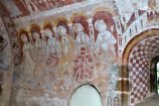. . . I no longer hold any religious beliefs. I shed those almost six decades ago.
But Steph and I do enjoy exploring many of the fine—awesome even—churches, abbeys, and priories that were constructed centuries ago by Christian communities to reflect ‘the glory of their omnipotent God’.
On the map below I have marked those we have visited over the years. Each icon is accompanied by several photos, and links to websites, my own blog posts and/or photo albums, where you will find much more information.
Ruins have a blue marker; churches that are still open have a purple one. Cathedrals are marked dark red for those we’ve actually been inside, whereas those viewed from a distance are marked yellow. One 16th century religious curiosity, Rushton Triangular Lodge, has a black icon.
There are also three pagan sites on the map that pre-date Christianity by centuries if not millennia, shown with green icons.
Most of the monasteries and priories were founded by the Cistercians, the Benedictines, and Augustinians among others in the immediate centuries following the Norman invasion of England in 1066.
 During the Dissolution of the Monasteries enacted by Henry VIII between 1536 and 1541 many of these communities were disbanded and their assets claimed by the Crown or handed willy-nilly to allies of the King. We only see their ruins today, some more intact than others, but all leaving an impression of what they must have looked like in their heyday.
During the Dissolution of the Monasteries enacted by Henry VIII between 1536 and 1541 many of these communities were disbanded and their assets claimed by the Crown or handed willy-nilly to allies of the King. We only see their ruins today, some more intact than others, but all leaving an impression of what they must have looked like in their heyday.
Fortunately many of the great cathedrals still stand proudly. It never ceases to amaze me—inspire even—just what it took to build these impressive edifices, up to a thousand years ago. Take late 12th century Wells Cathedral, for example.

Some are more recent. For example, St Paul’s (below) in London was designed by Sir Christopher Wren in the late 17th century after the Great Fire of September 1666 had destroyed the original church. It survived the London Blitz during World War II.

In Liverpool, there are two 20th century cathedrals: Anglican and Catholic. The former took 74 years to complete between 1904 and 1978. The latter, a very modern design, opened in 1967 after six years. Another recent cathedral is Coventry (designed by Sir Basil Spence), which opened in 1962 and stands beside the bombed-out ruins of the original cathedral.
Since we became members of the National Trust and English Heritage in 2011, we have visited many of the ruined abbeys and priories under their care. Here in the northeast of England where we now live, there are many ruined abbeys and priories, as well as several early Anglo-Saxon chapels still in use. After all, the ancient Kingdom of Northumbria was a cradle of Christianity in these islands.
Since there is so much more information in the map links, let me just focus on one ruined abbey and two churches that have particularly caught my attention.
Standing beneath a steep slope in a secluded valley of the River Rye in the North York Moors, Rievaulx Abbey is surely one of the best. It is managed today by English Heritage.
It was the first Cistercian abbey founded in this country in 1132 by twelve monks from Clairvaux Abbey in northeast France. It was closed during the Dissolution in 1538.
What an impressive building, made even more so by its location. From Rievaulx Terrace above, you can get a bird’s-eye view of the whole site.
In the heart of the Gloucestershire countryside in the village of Kempley, the little Church of St Mary’s is an absolute jewel. Built in the late 12th century, it has some of the most exquisite Romanesque fresco paintings. It really is remarkable that they have survived all these centuries given the vandalism that occured during Henry VIII’s reign and afterwards. We visited in May 2015, and I had intended to return one day, but now that we are based in the northeast, that seems less likely. Nevertheless, this small church has left me a lasting impression. It is certainly worth a detour if you are ever in the vicinity.
Lastly, I have chosen St. Michael and All Angels Church, Great Witley, surely Britain’s finest baroque church. It stands next to the burnt out ruins of Witley Court in Worcestershire.
Completed in 1735, it was originally quite plain inside. However, in 1747, it underwent a remarkable transformation when the owner of Witley Court, the 2nd Baron Foley acquired furnishings, paintings, and stained glass windows from Cannons House that was demolished by the 2nd Duke of Chandos and its contents sold. You can read more about the church’s history here.
Well, those are my three choices. Take a look at the map and see if you agree. They are all special in so many ways. And I always come away with my spirits uplifted, but without religious experience per se.


























